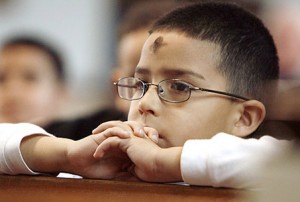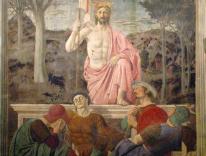 Note: This pious kid is not ours.
Note: This pious kid is not ours.
As someone who explains Christianity for a living, I thought I would be well equipped to explain it to our own kid. To the endless series of questions -- Why do you call that man Father? Why can't I have communion yet? What does Alleluia mean? Will I be allergic to the steam coming out of that, that, thing the man is swinging? -- I have usually had answers that could be simplified to kid-level. Recently though, I was faced with the first catechetical question that truly stumped me: Why do we put ashes on our heads?
Now it's been several weeks since Ash Wednesday, and I still haven't come up with a satisfactory answer for our preschooler. Our usual catechetical setting for liturgical gestures and adornments is during the quiet parts of Mass, in hushed tones from below the pew, where kids sit, seeing virtually nothing but purses, umbrellas, and Cheerios. But this particular question occurred during a different setting: the nighttime, bedside discussion about what's going to happen the next day, a kind of catechetical vigil we perform for an upcoming holiday or holy day.
This tradition began in order to explain secular holidays, such as Labor Day, Columbus Day, and Presidents Day -- you know, days off from preschool. And with each of these holidays, I could concoct a story that makes sense at kid-level. (The Columbus Day story remains the favorite, probably due to my insertion of piracy and dramatic weather events.) The days off for Jewish holidays? No problem! Let's learn about the lunar year! Even the major feasts of Christmas and Easter are reasonably simple to explain, primarily because they have gripping narratives to tell. To be honest, I've found the Trinity (Why do we say Father, Son, Holy Spirit?) easier to discuss than Ash Wednesday.
It's not that I don't know the historical backgrounds to this ritual behavior in the Ancient Near East, in the history of Christianity, in the modern liturgical renewal movement, and so on. It's not that I don't know the scriptural sources that supposedly explain the ritual. It's not like I didn't try the standard responses about ashes, dust, change, conversion, humility, and the catch-all, that it's about being good.
But now after weeks of pondering, I've come to the conclusion (quite surprising to myself) that I shouldn't try to explain the ashes of Ash Wednesday. As scholars of ritual, such as Catherine Bell, Pierre Bourdieu, and Ronald Grimes, so often remind us, there are many practices not explicable in words, practices which have a logic of their own and are not expressible in language. Sometimes the gesture is the meaning, and anything I say will make it less understandable. As a case in point, our kid loves watching baptisms, and she has not yet asked what that ritual means -- she just gets it, through the different logic of ritual practice.
This conclusion doesn't apply to all, or even most, aspects of our shared ritual life. And in the coming years, our daughter will get more and more explanations of what we do -- ways of wedding the logic of practice with the logic of words. But for now, I am learning a new lesson in catechizing: it's appropriate in some cases to let the ritual be. Or, we might say, to let the ritual do. Its meaning resonates deep in the bones of humanity, deeper than words can go.
Please email comments to [email protected] and join the conversation on our Facebook page.
Share
Previous Story
Who needs whom?
Next Story
Compromise or Stalemate?
